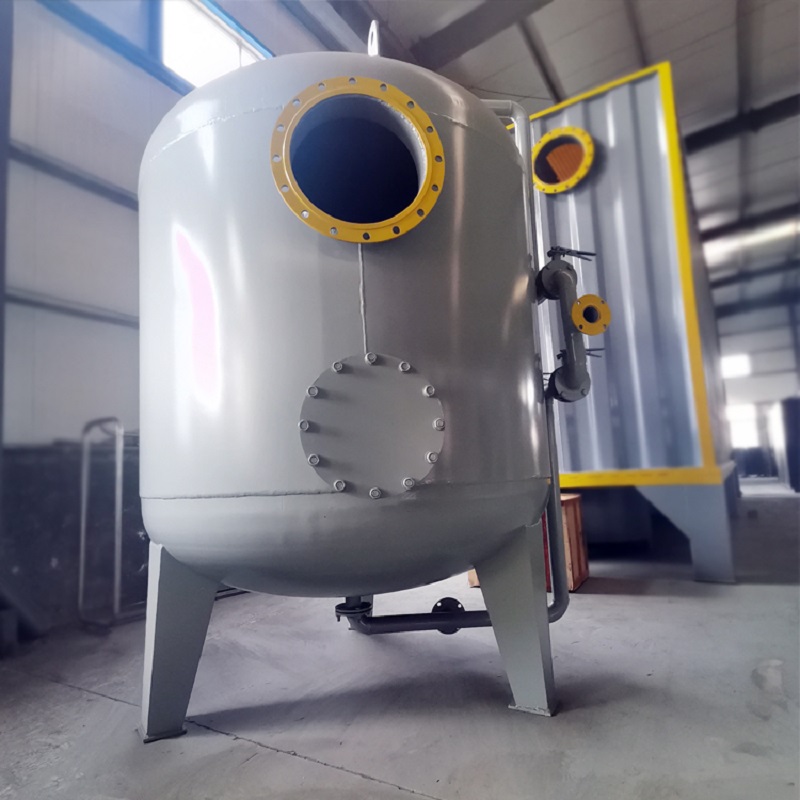
Multi media filter is an efficient water treatment equipment that combines different particle sizes and densities of filter media (such as quartz sand, anthracite, activated carbon, etc.) to achieve the function of gradually intercepting suspended solids, colloids, organic matter and other impurities in water.
1、 Working principle
Multi media filters achieve water purification based on deep filtration and adsorption:
① Physical interception: When water flows through the filter layer from top to bottom, larger particles are intercepted at the top layer and smaller particles are removed at the deep layer.
② Chemical adsorption: Activated carbon and other media adsorb pollutants such as organic matter and colloids through surface pores and chemical reactions.
③ Synergistic effect: Different media (such as quartz sand, anthracite, activated carbon) form a hierarchical structure, with coarse filtration in the upper layer and fine filtration in the lower layer, improving filtration efficiency.
2、 Structural characteristics
① Filter layer design:
·Upper filter material: with large particle size and low density (such as anthracite and activated carbon), it plays a role in coarse filtration.
·Lower filter material: with small particle size and high density (such as quartz sand and magnetite), it plays a role in fine filtration.
·Filter material selection: It is necessary to meet the requirements of density difference and avoid mixing layers during backwashing.
② Core components:
·Cylinder body, water distribution component, backwash air pipe, support component, filter material, exhaust valve, etc.
·The ratio of filter material particle size to filling height is usually 800-1000 (design specifications).
3、 Application Fields
Multi media filters are widely used in the following scenarios:
① Industrial water treatment:
Power industry: Treat boiler feedwater to prevent scaling and corrosion.
Chemical industry: Pre treat process water to ensure production stability.
Electronic industry: Removing particulate impurities to create conditions for processes such as reverse osmosis and ion exchange.
② Municipal water treatment:
Waterworks: Remove impurities such as sediment and algae from raw water to reduce turbidity.
Wastewater treatment plant: In the advanced treatment stage, suspended solids are removed to improve the effluent quality.
Desalination of seawater: The pre-treatment stage removes suspended particles and organic matter, reducing the burden on the reverse osmosis membrane.
③ Circulating water treatment:
Industrial circulating cooling water system: removes rust, scale fragments, and extends equipment life.
Landscape water cycle system: maintaining clear water bodies and maintaining ecological balance.
④ Special fields:
Pool water treatment: Remove suspended solids and organic matter to ensure water quality and hygiene.
Irrigation of farmland: prevent clogging of sprinkler systems and improve irrigation efficiency.
4、 Advantages and disadvantages analysis
Advantages:
Stable filtration effect: Multi media combination improves impurity removal rate, and the effluent turbidity can reach below 3 degrees.
Wide applicability: The type and proportion of filter media can be adjusted according to water quality.
Strong processing capability: suitable for high flow water treatment, with a simple structure and easy maintenance.
High cost-effectiveness: Low initial investment, controllable long-term operating costs.
Disadvantages:
The filter material needs to be replaced regularly, which increases operating costs.
Limited filtration accuracy: The removal efficiency of microorganisms and bacteria is low, and other equipment needs to be used in conjunction.
Large footprint: It needs to accommodate multiple filter media and has a large volume.
Regular maintenance is required: backwashing and inspection are necessary to ensure the normal operation of the equipment.
5、 Summary
Multi media filters achieve efficient water purification by combining different filter materials, and are widely used in industrial, municipal, seawater desalination, and other fields. Its advantages lie in stable filtration effect, wide applicability, and strong processing capacity, but it requires regular replacement of filter media and maintenance, and has a low removal efficiency for microorganisms. In practical applications, it is necessary to select appropriate filter media and processes based on water quality and treatment requirements to achieve the best water treatment effect.